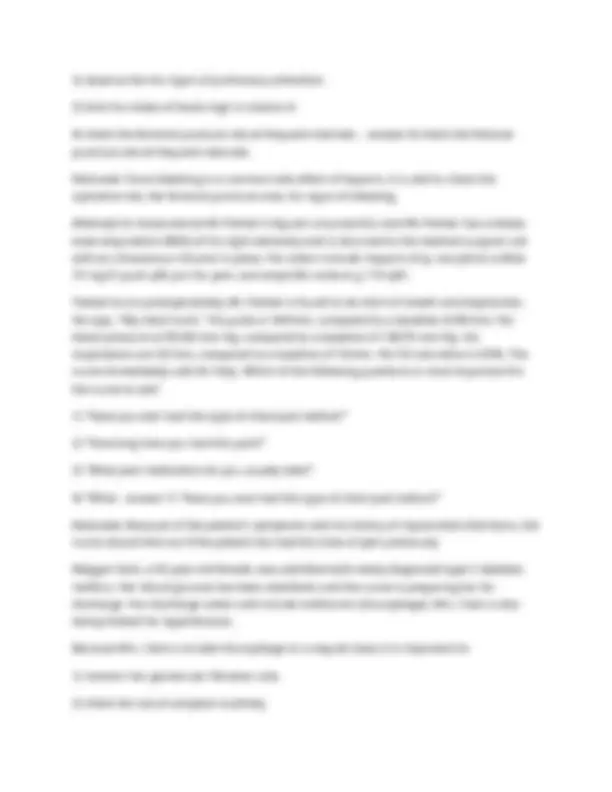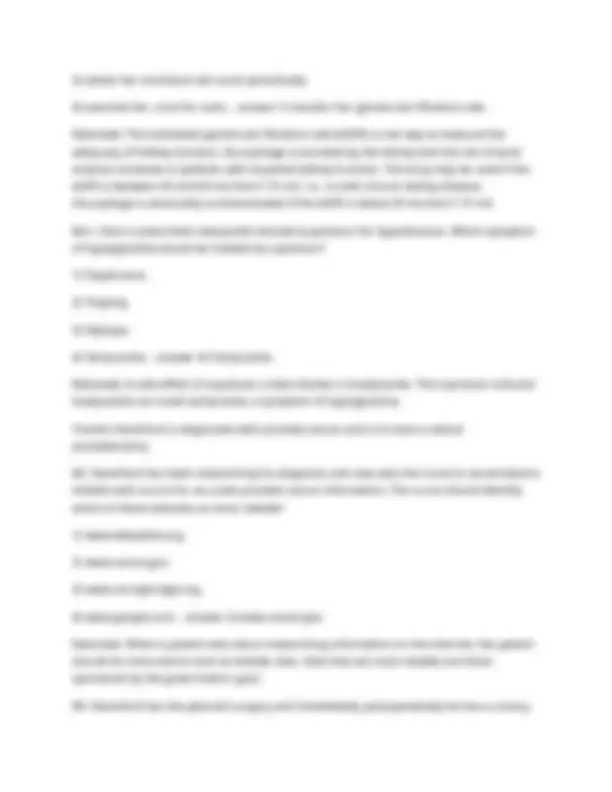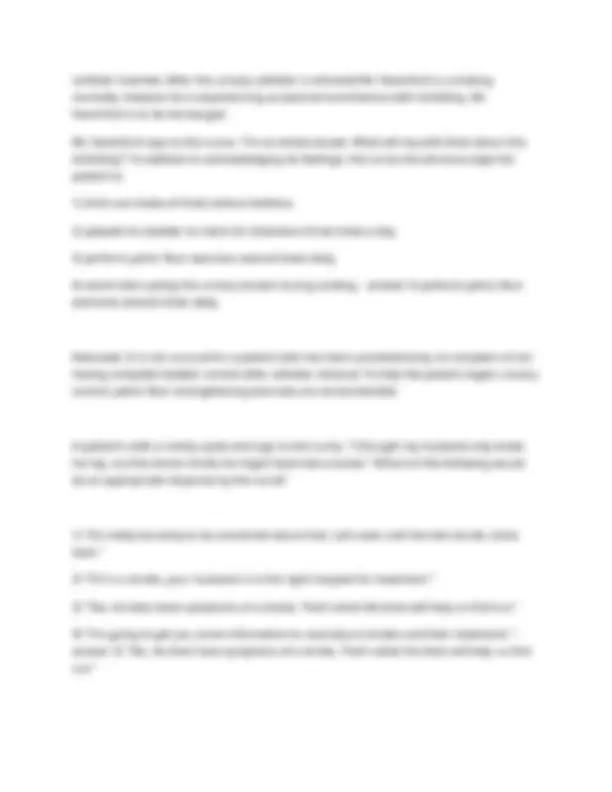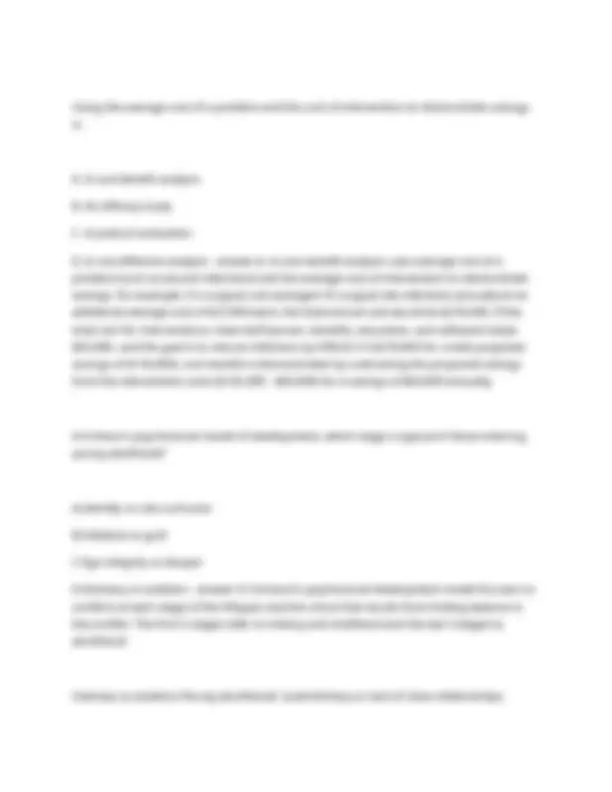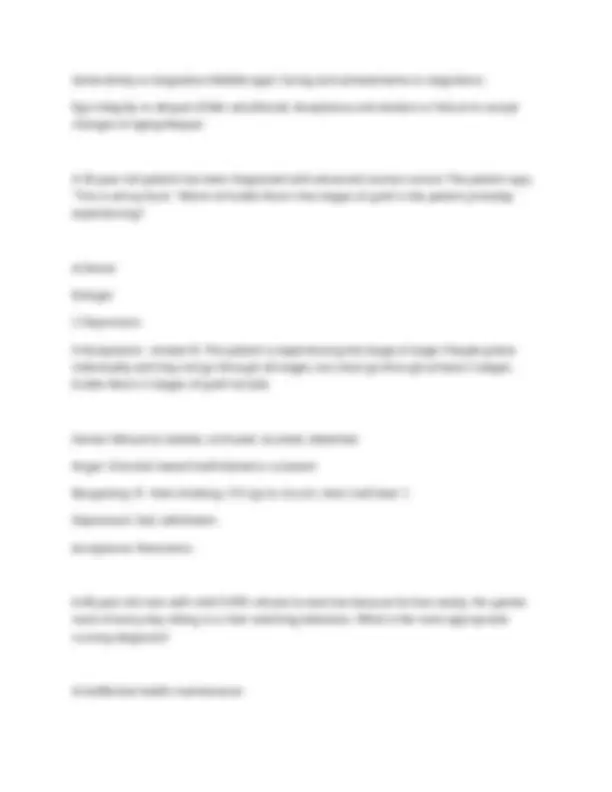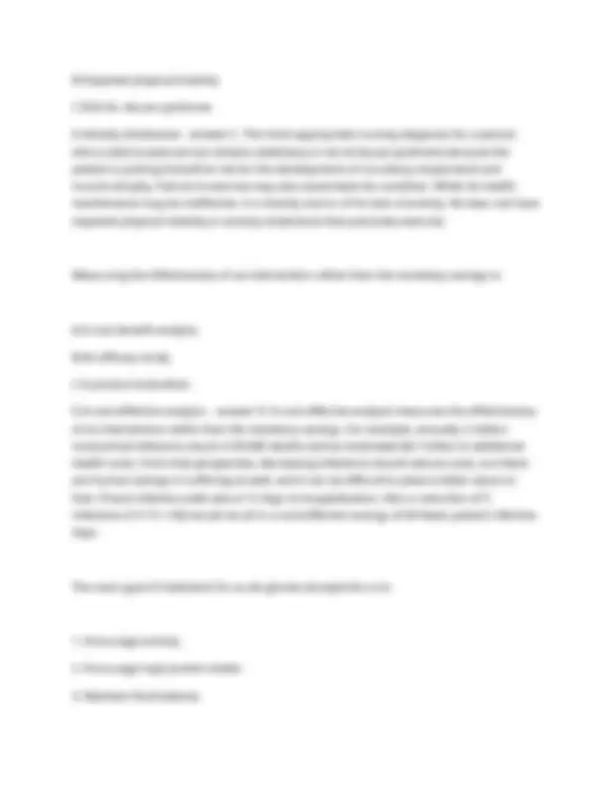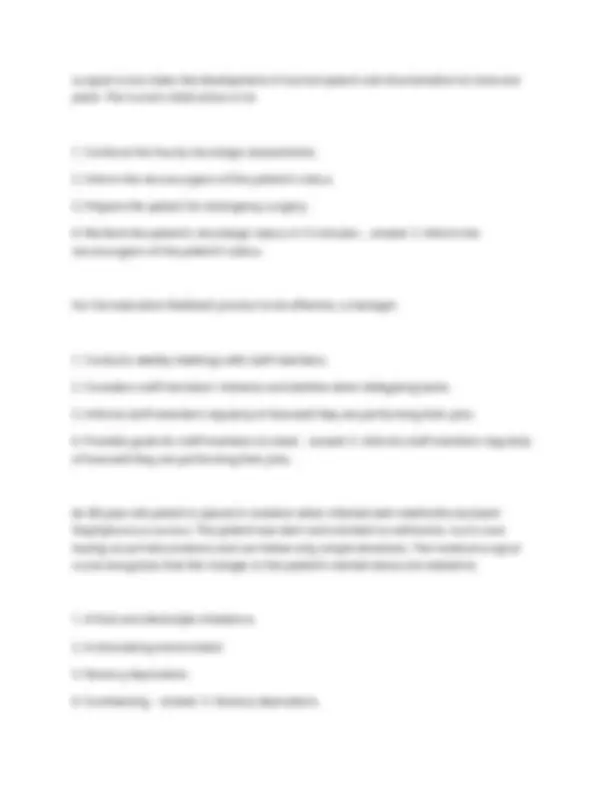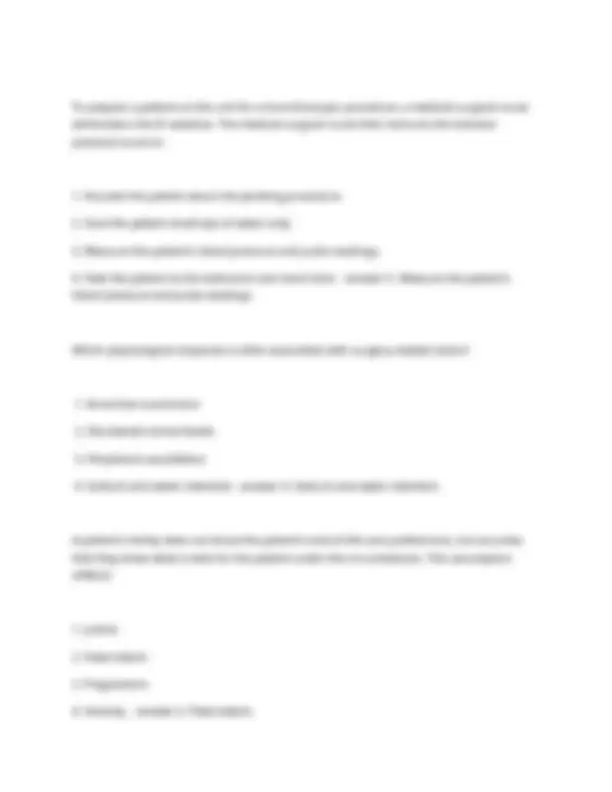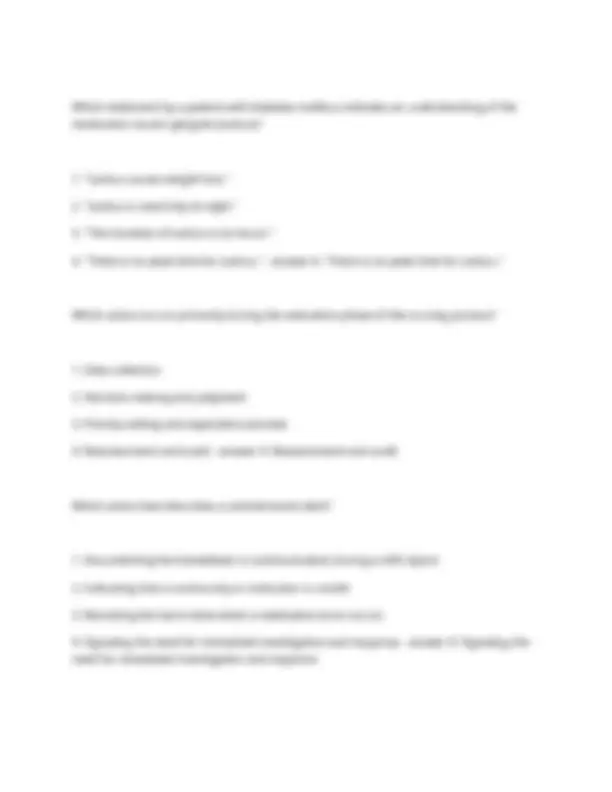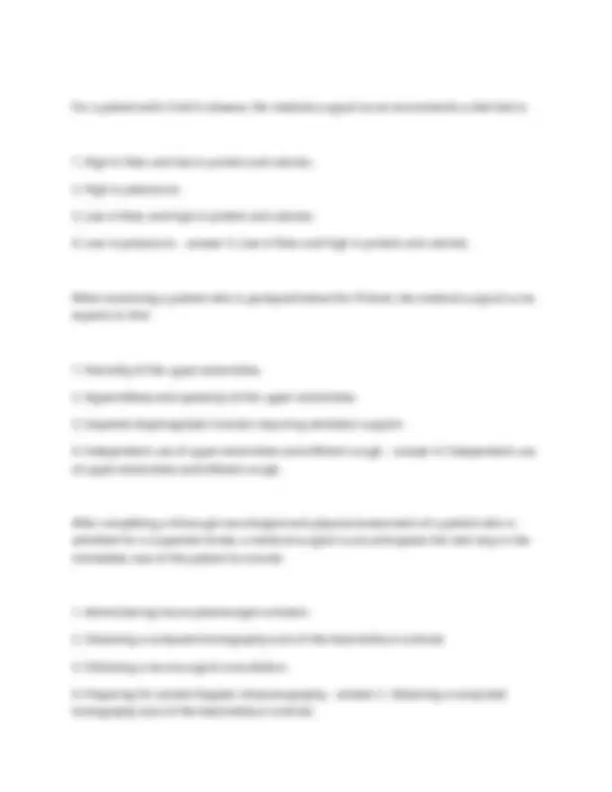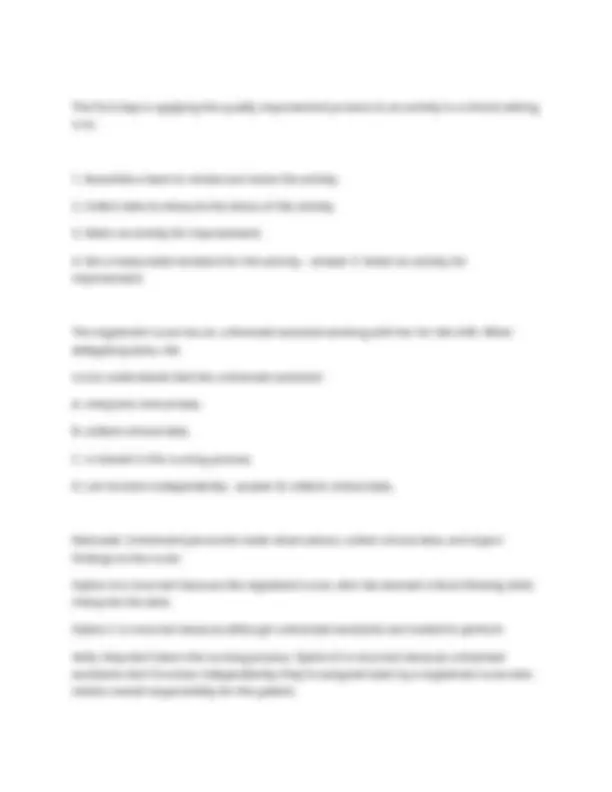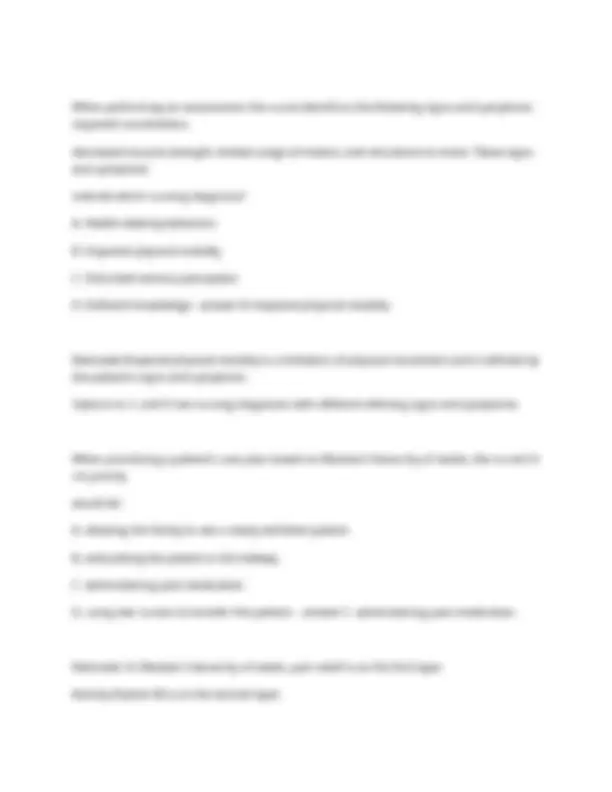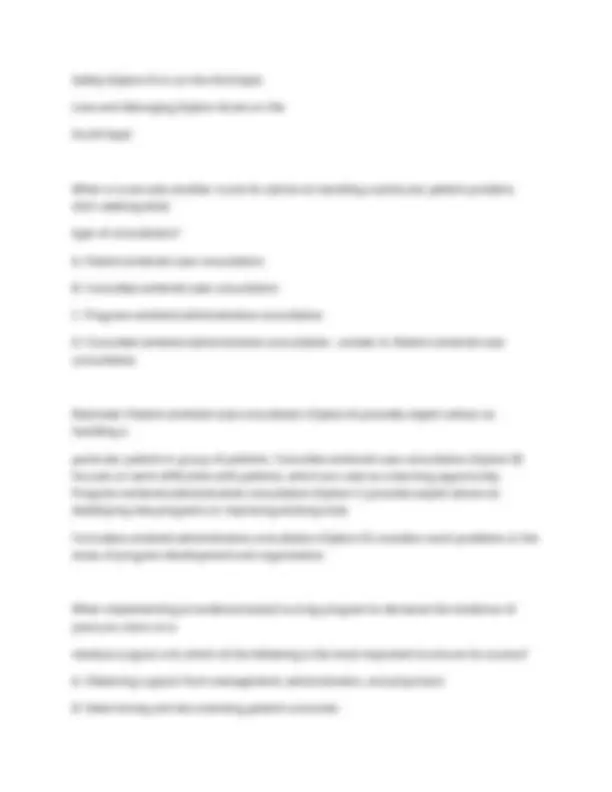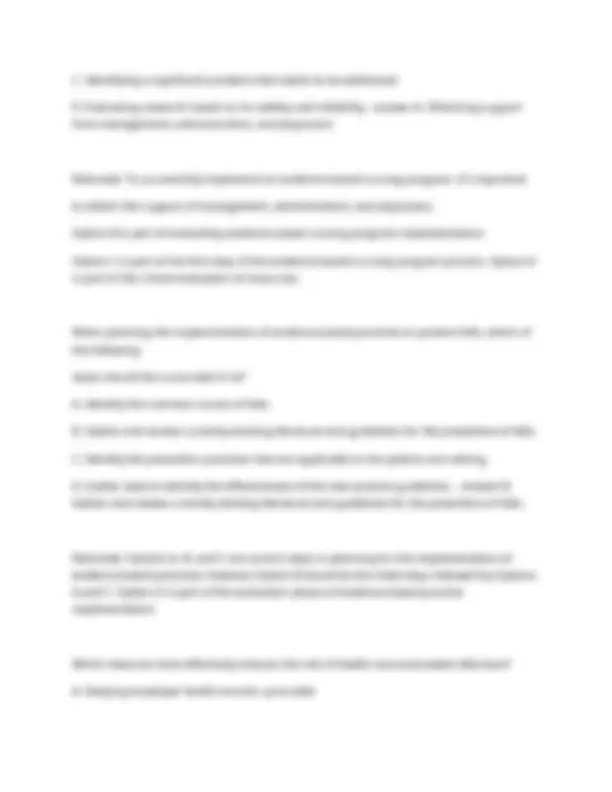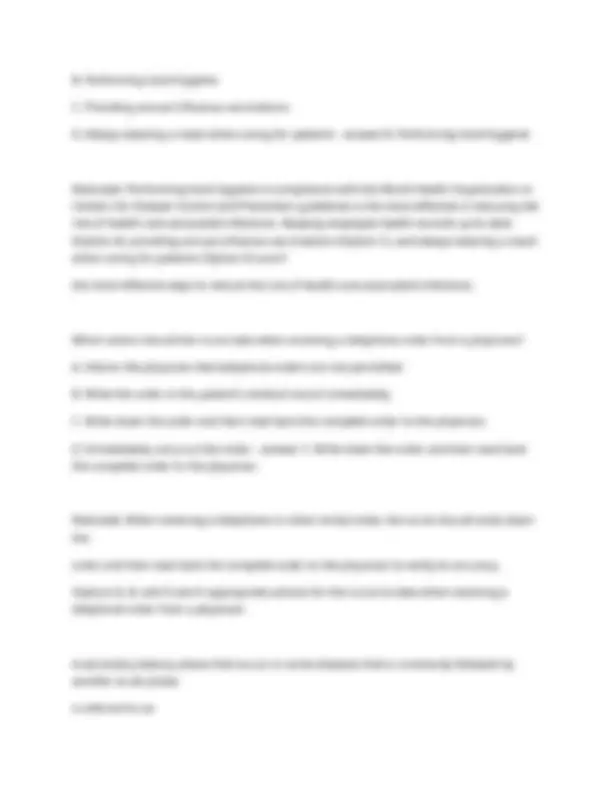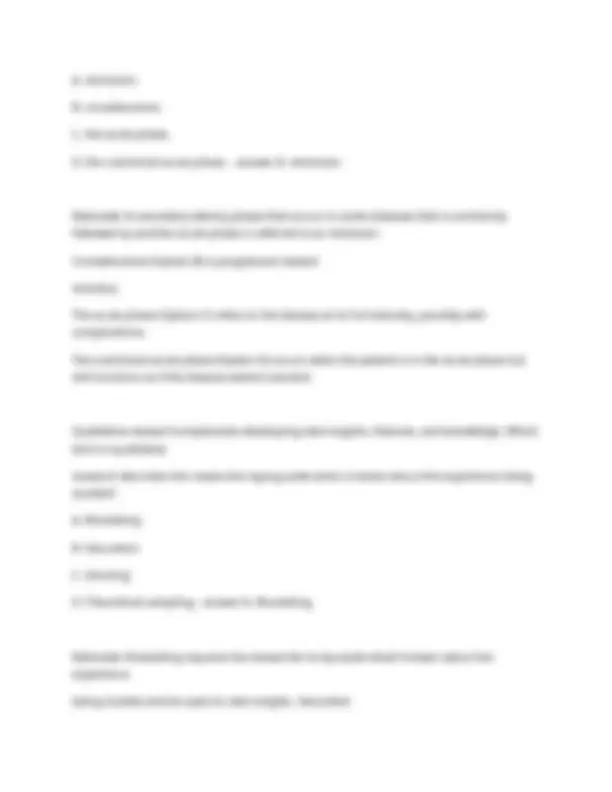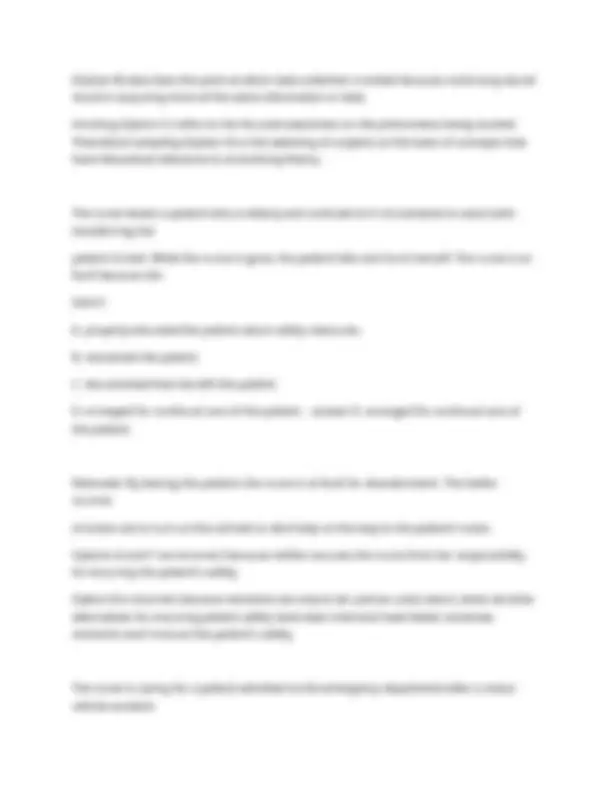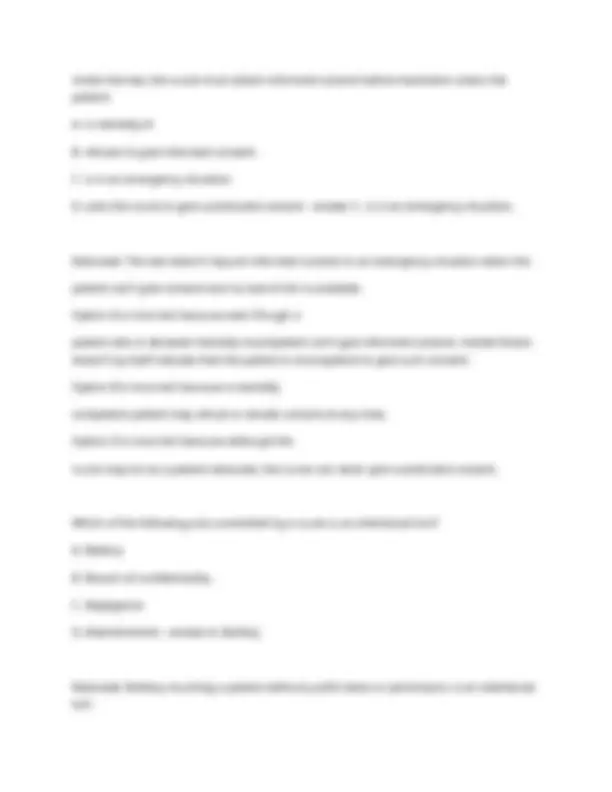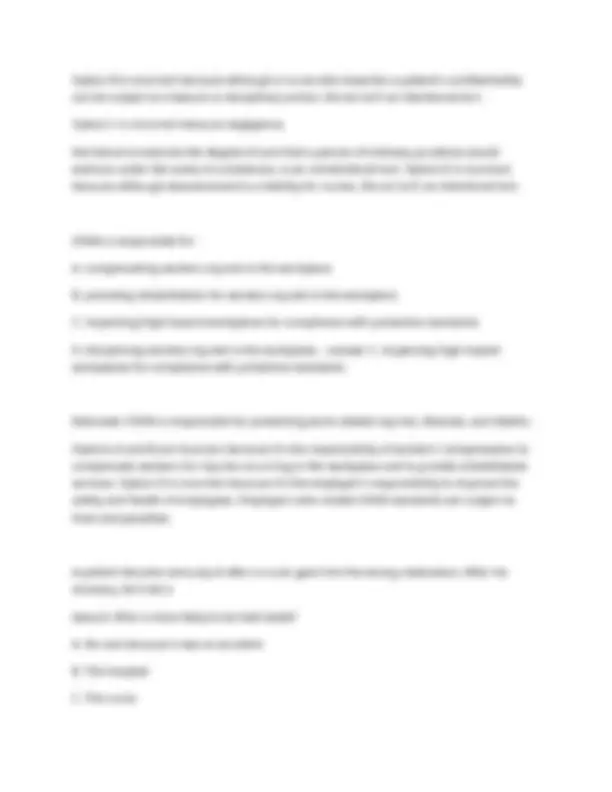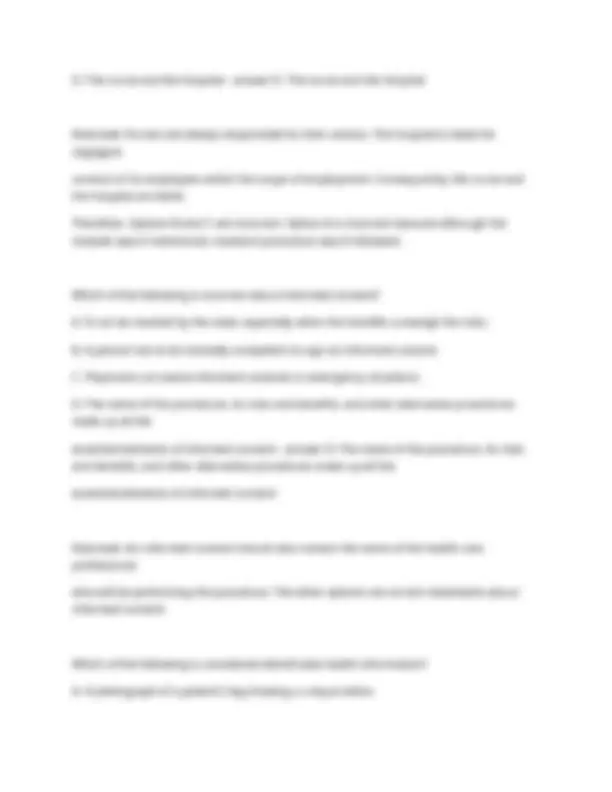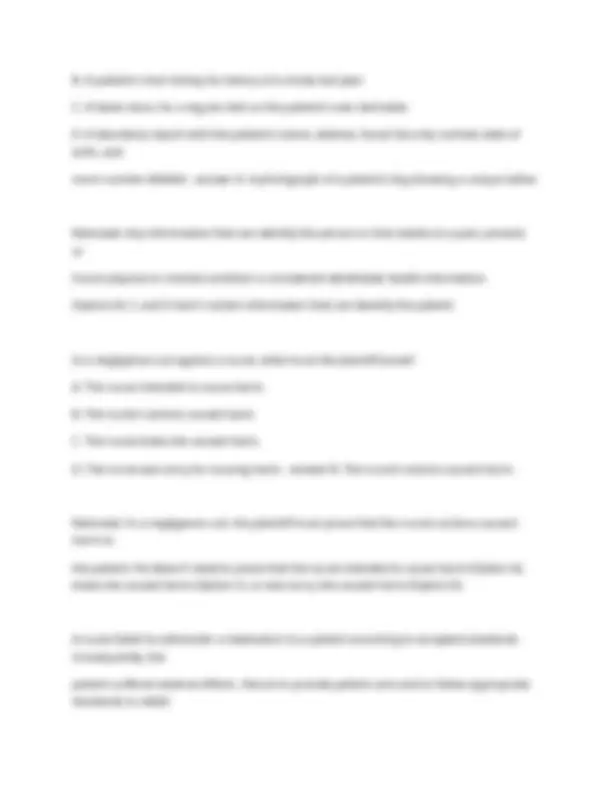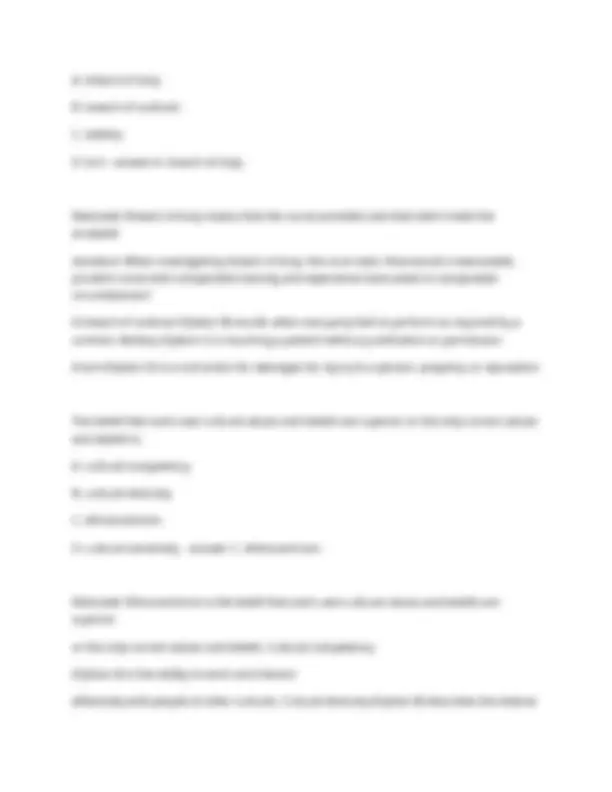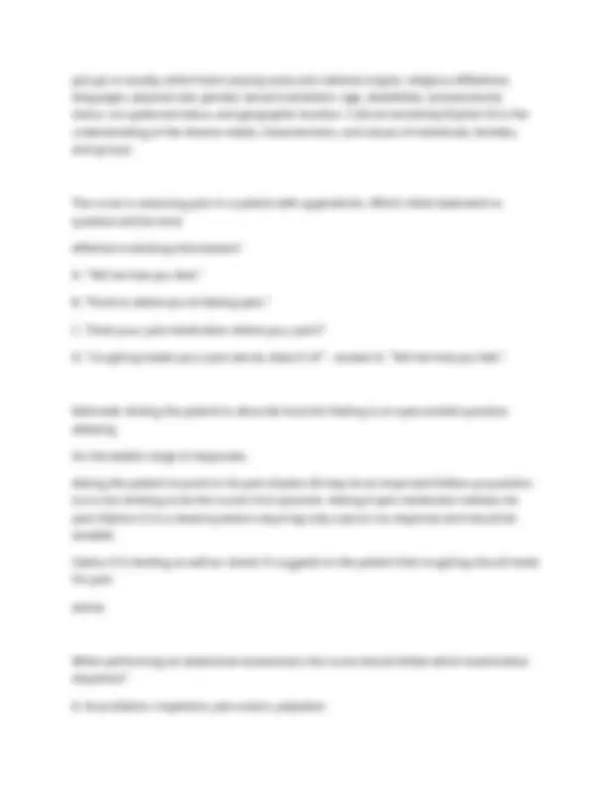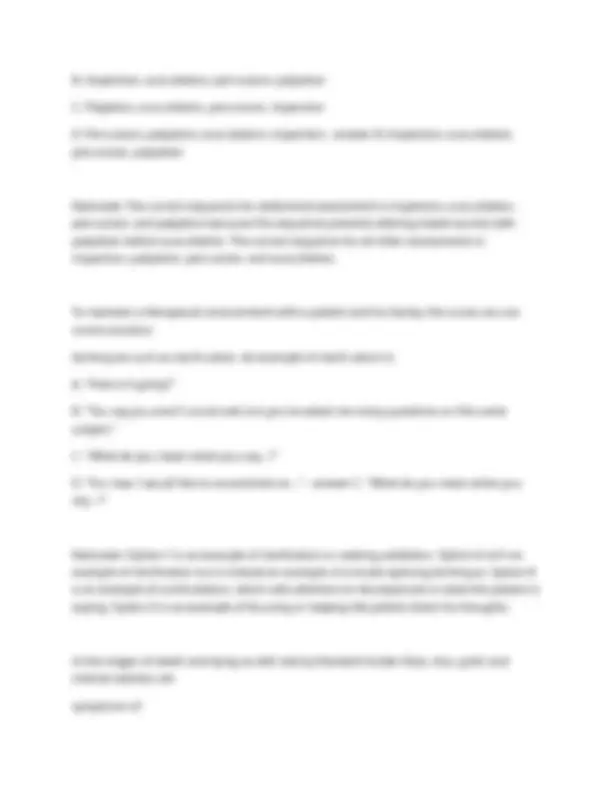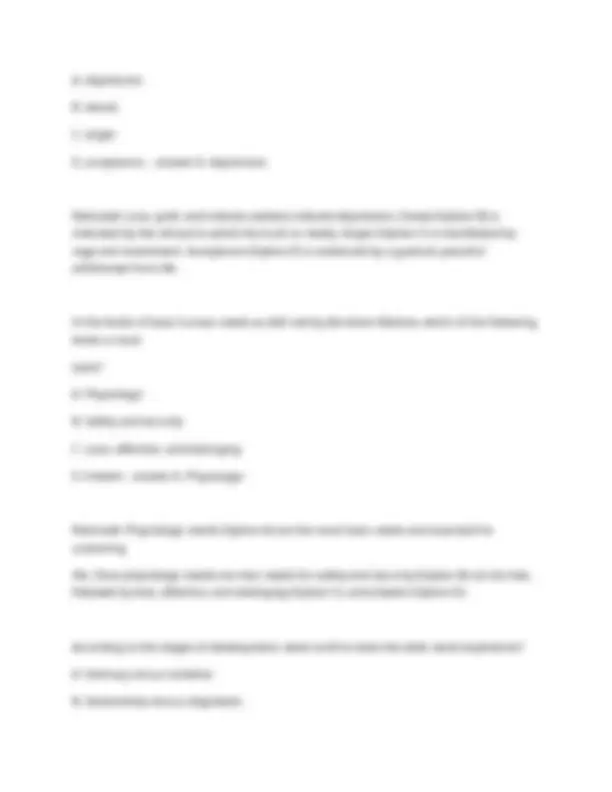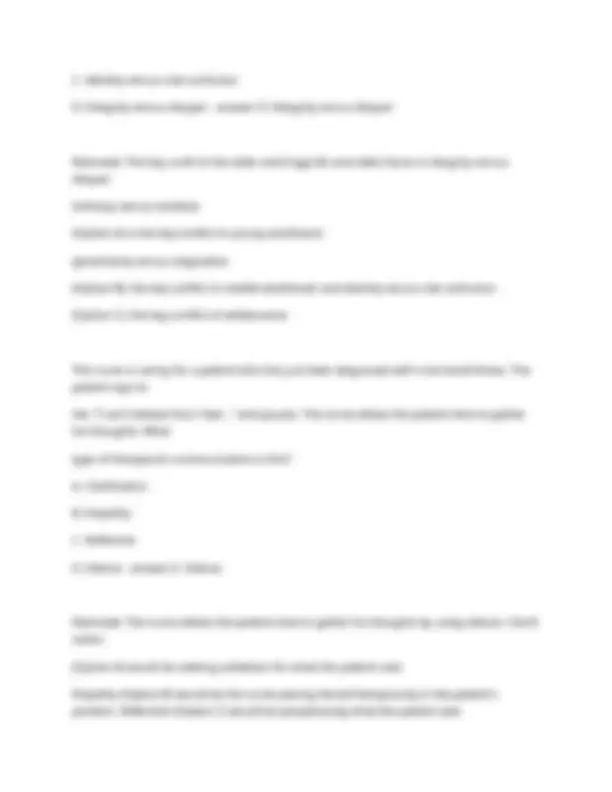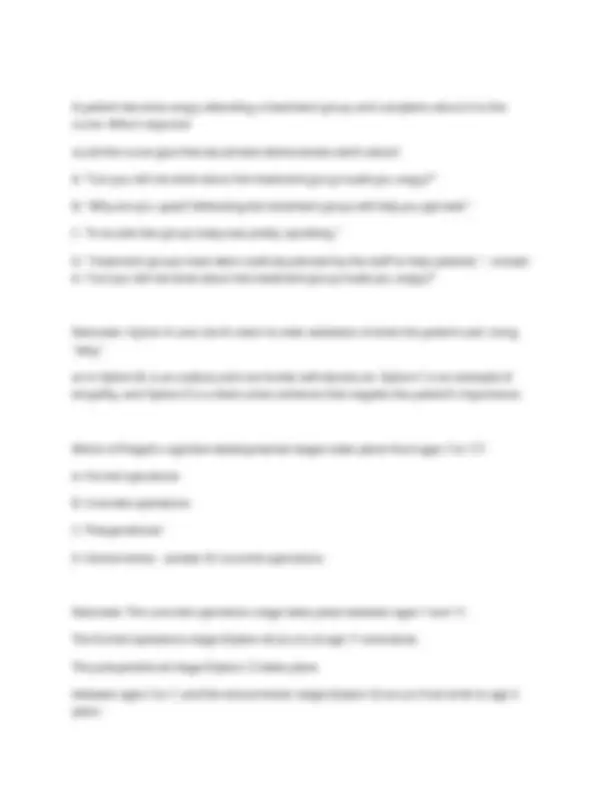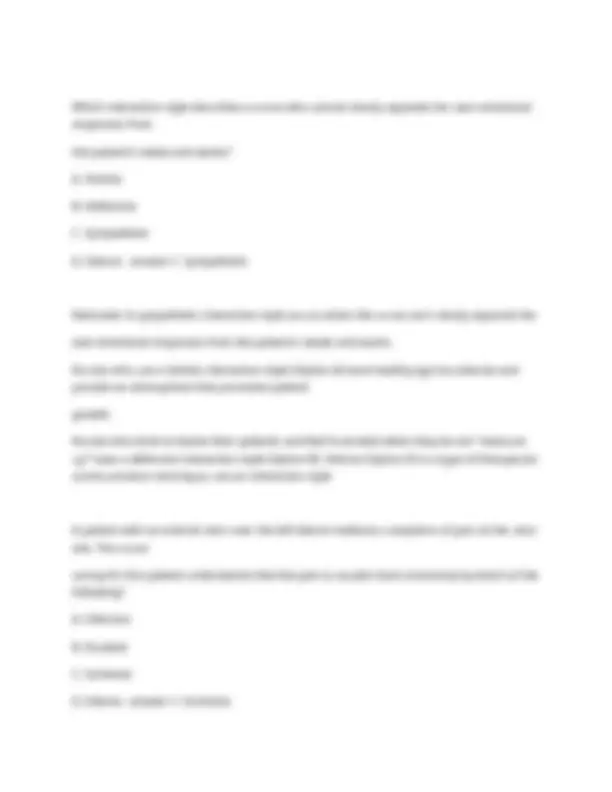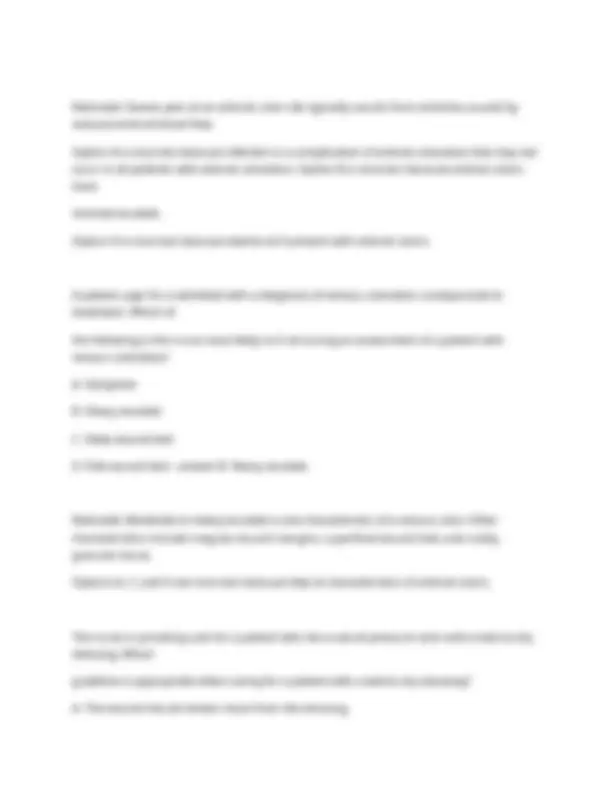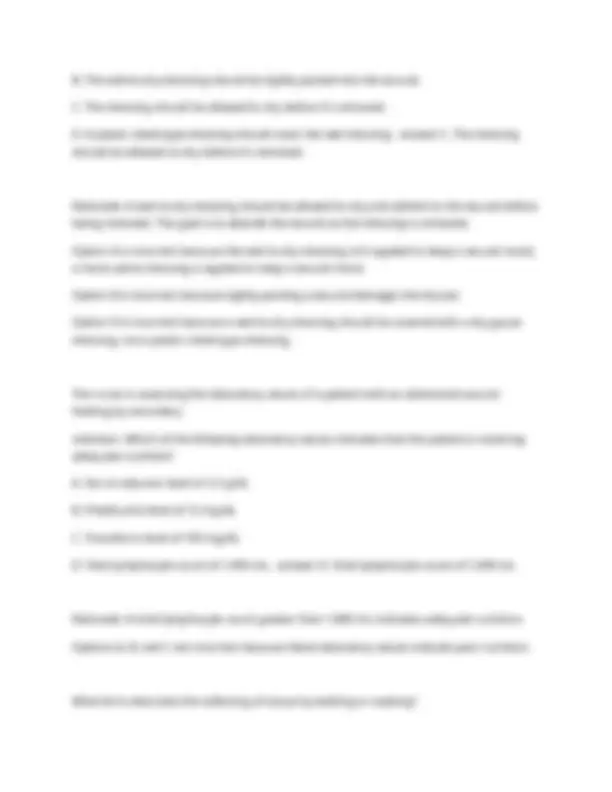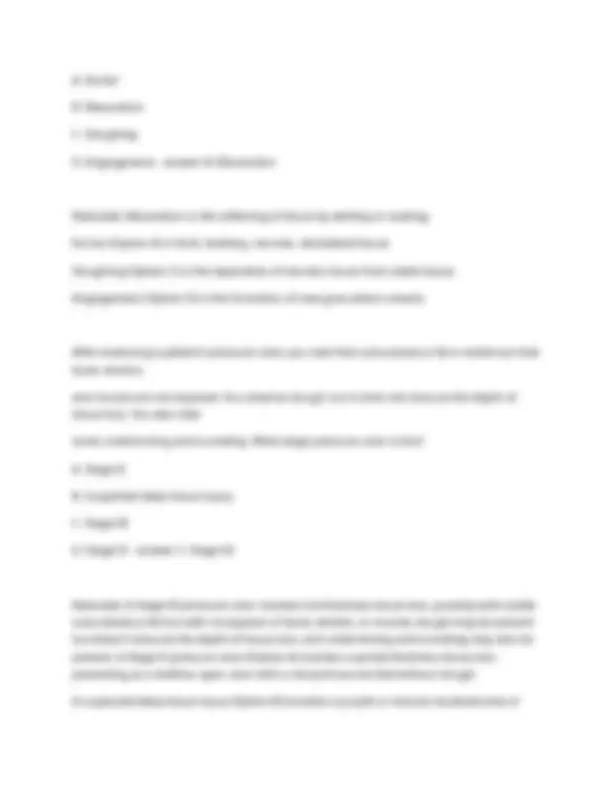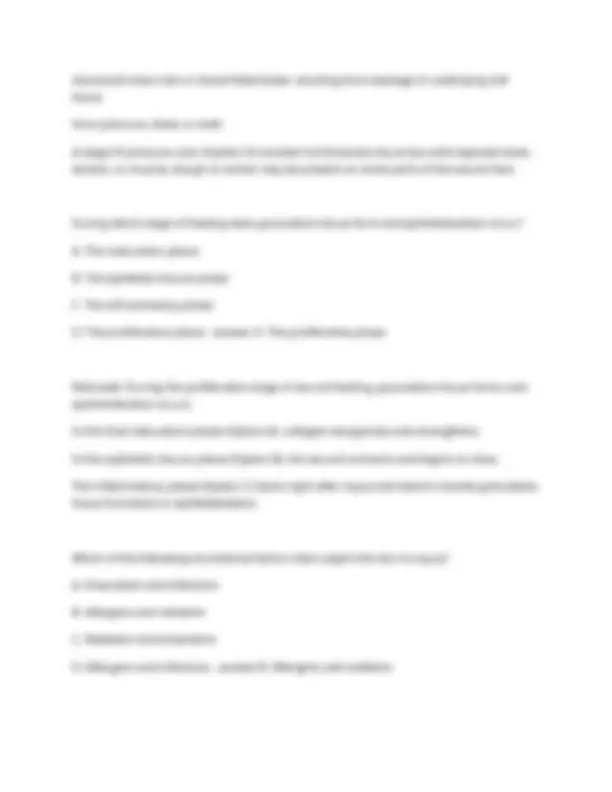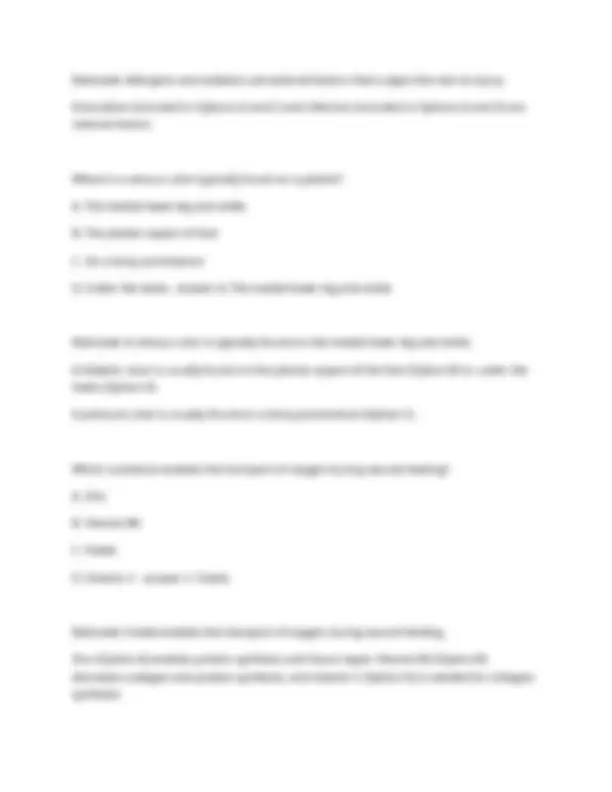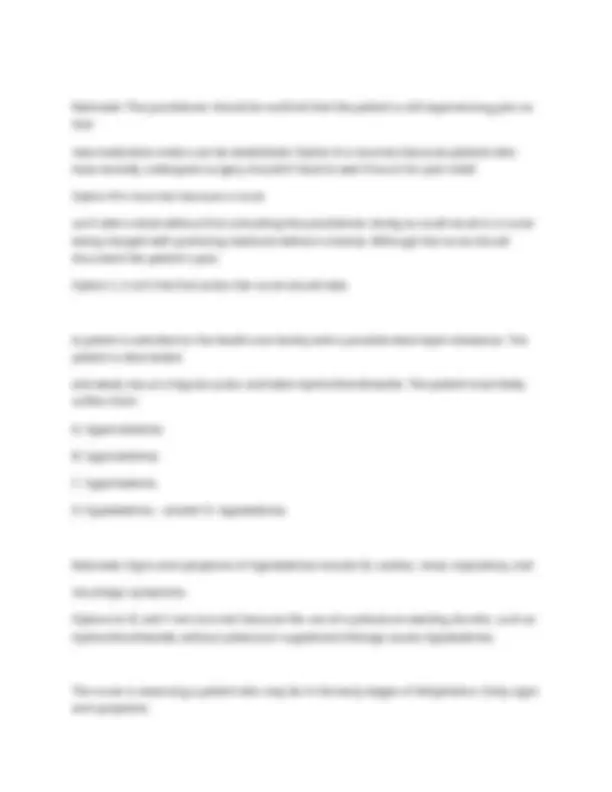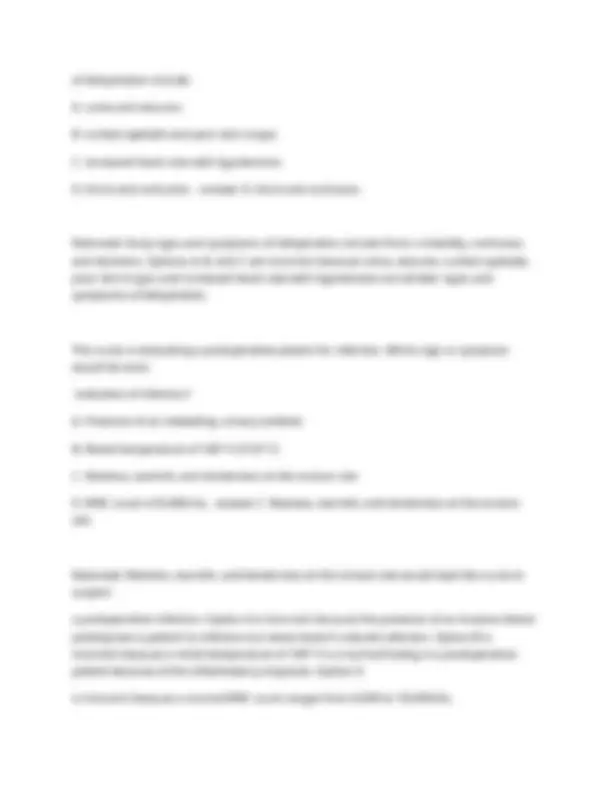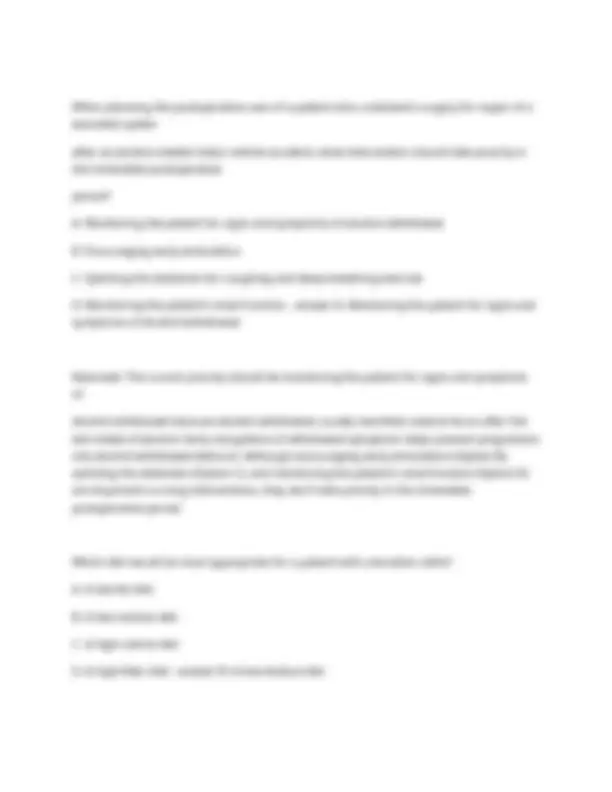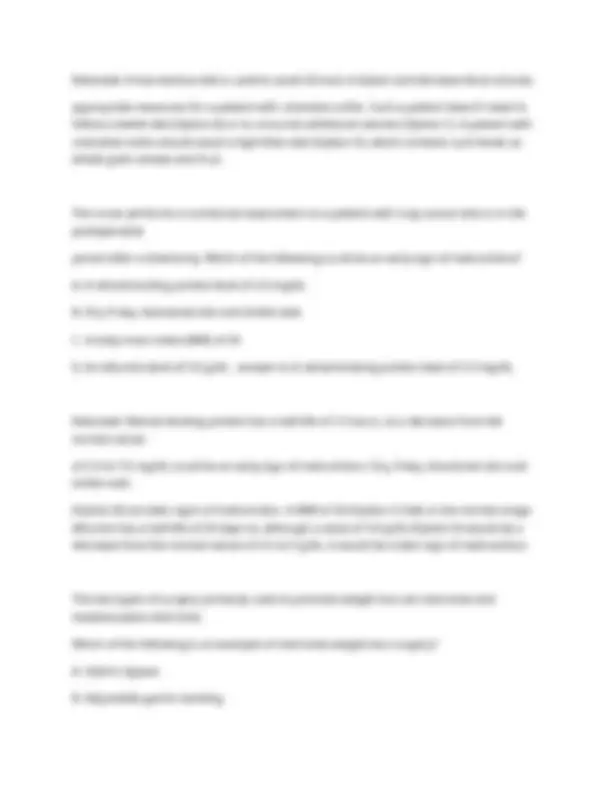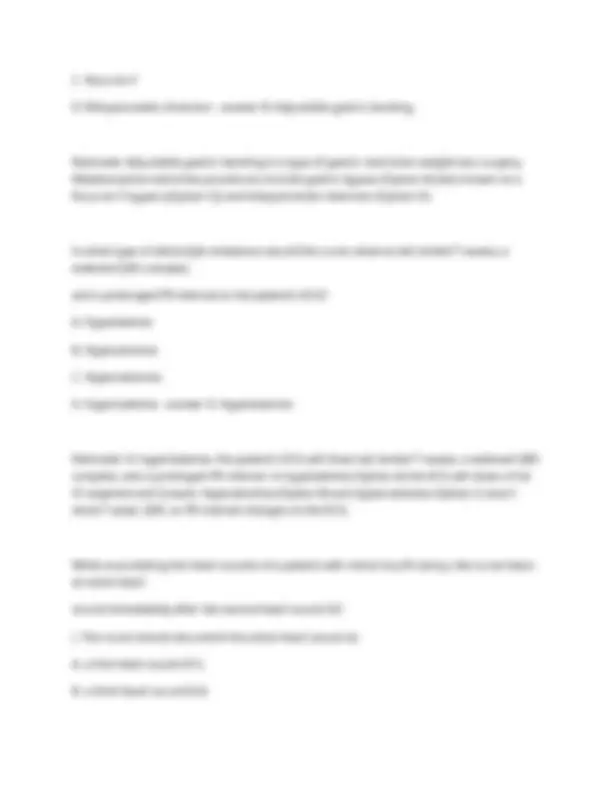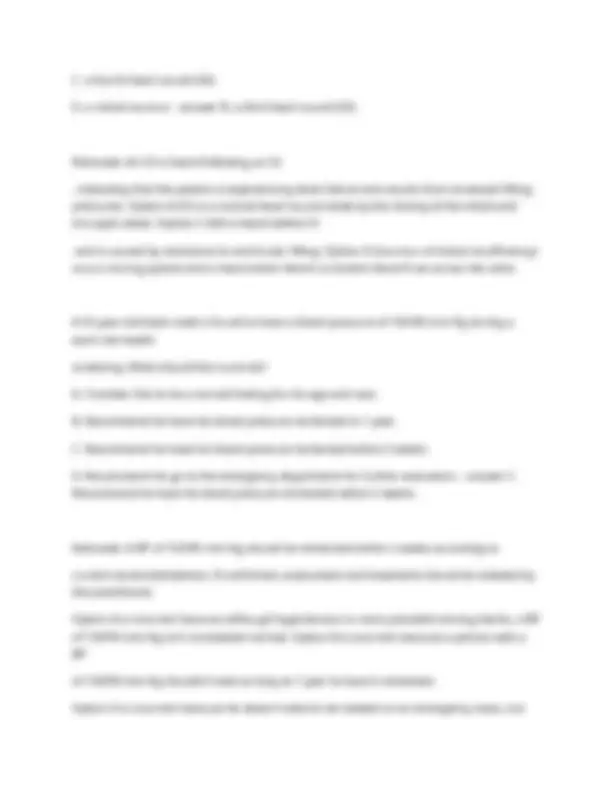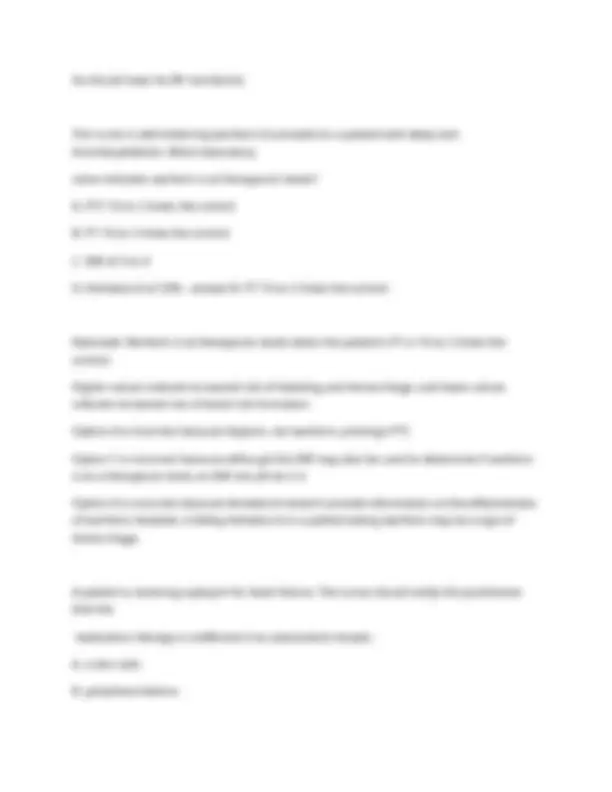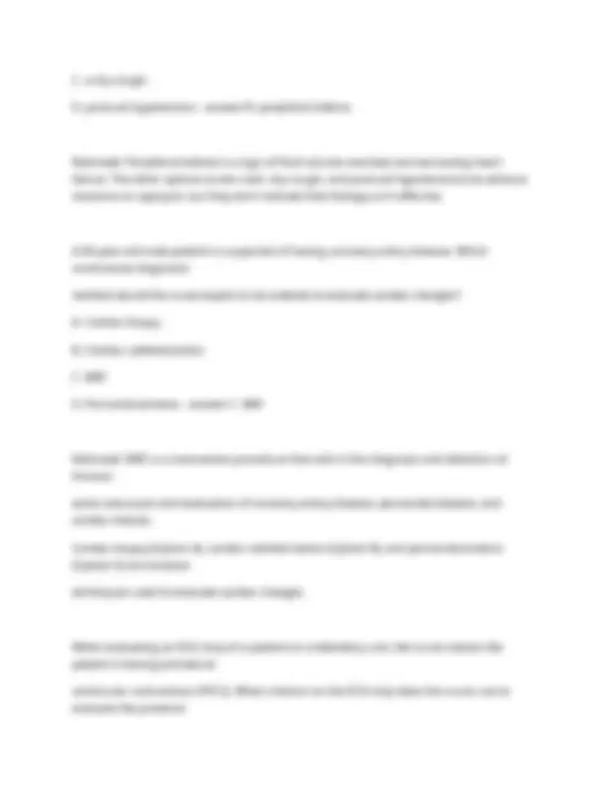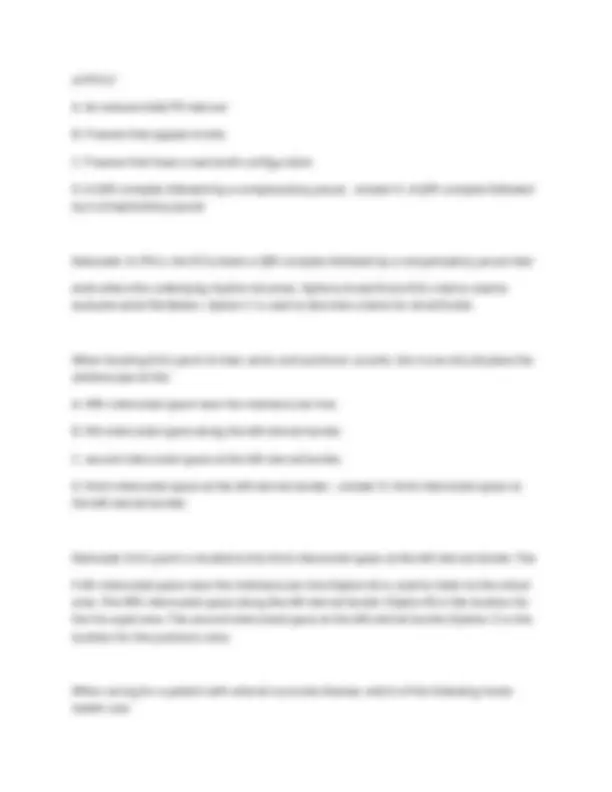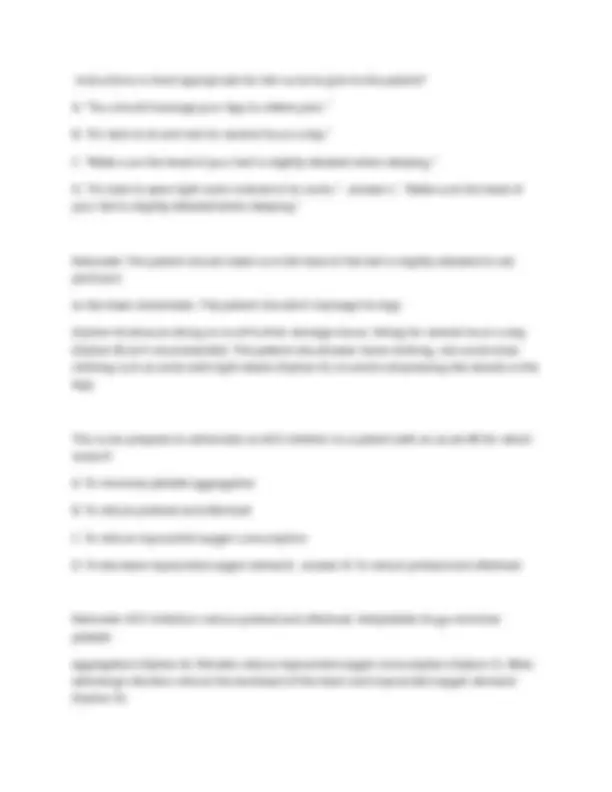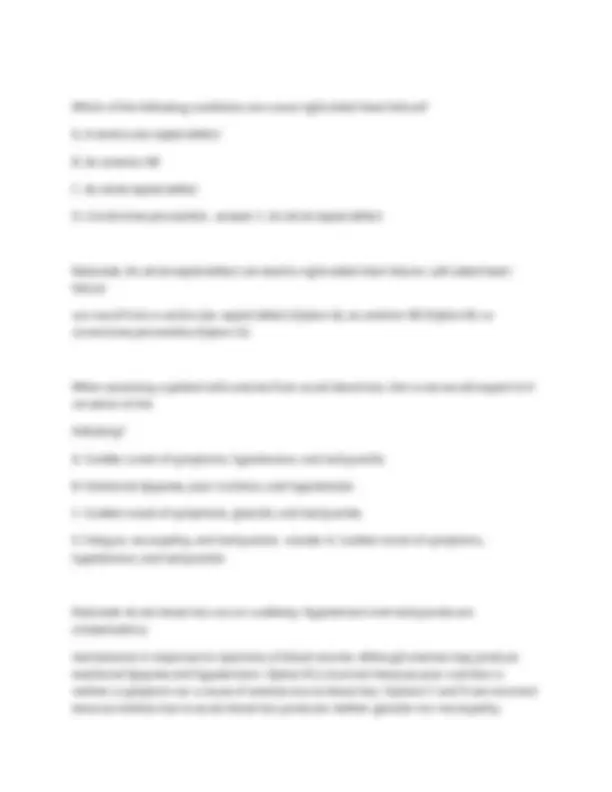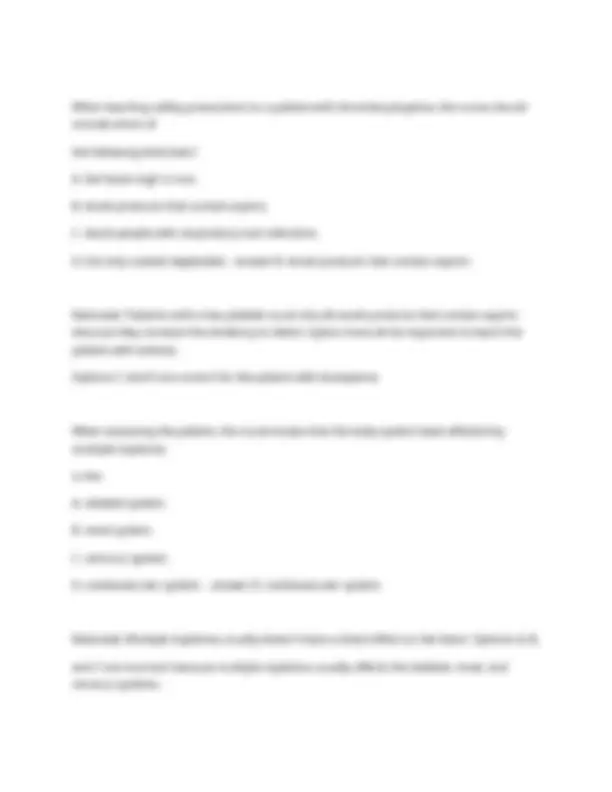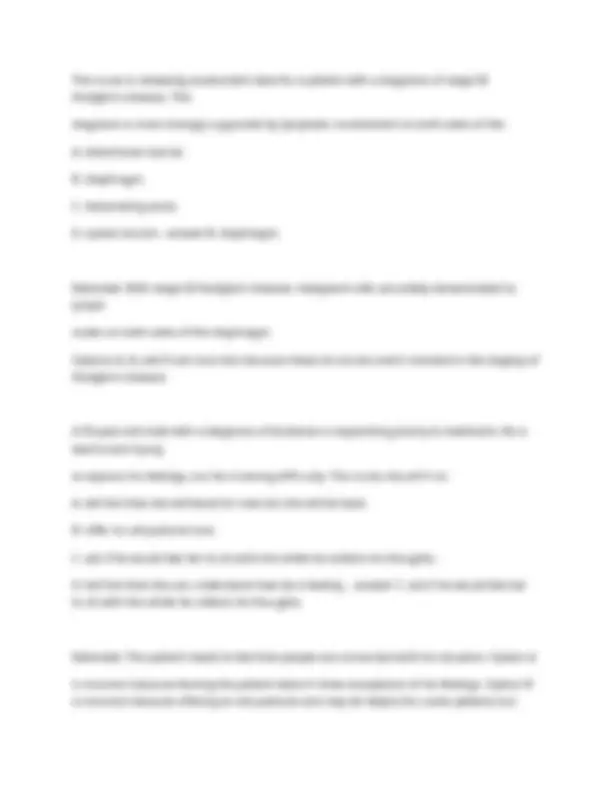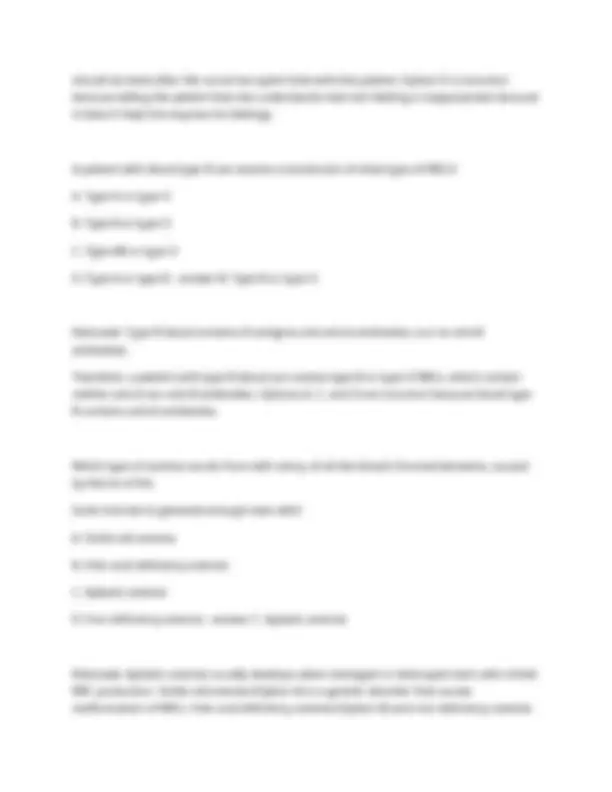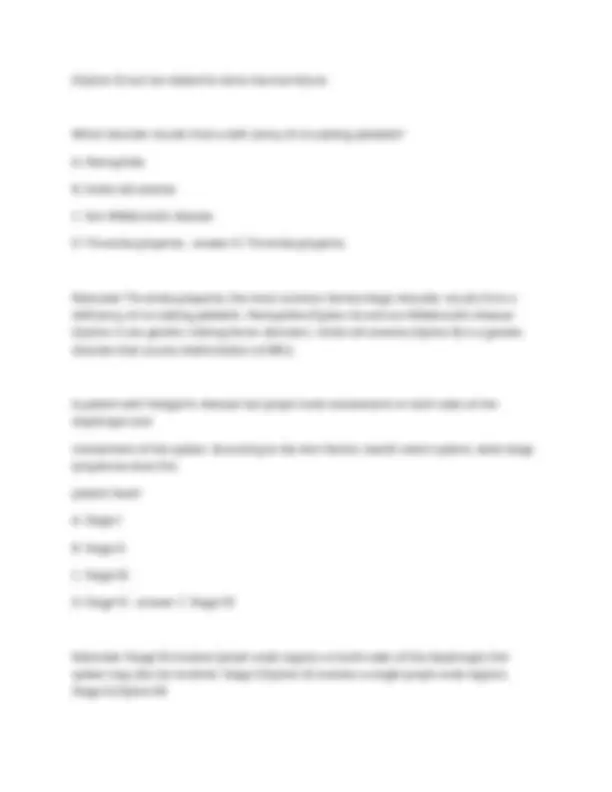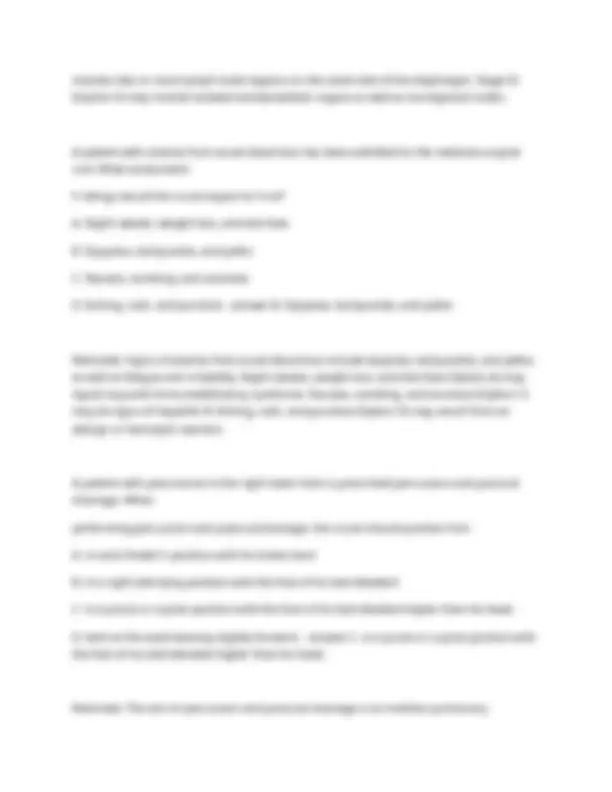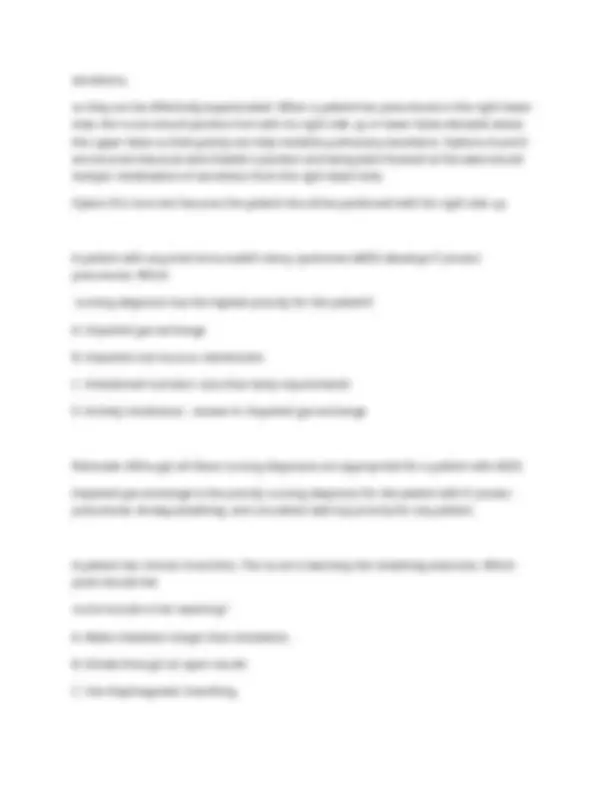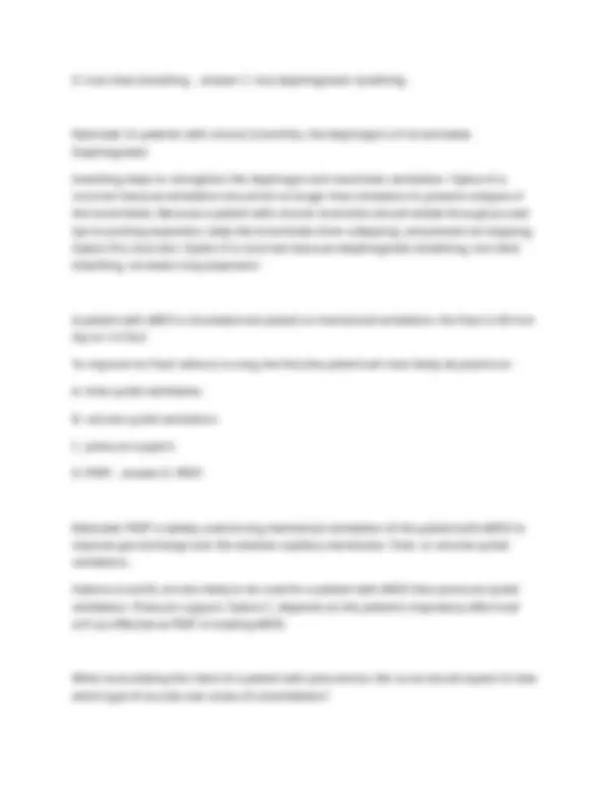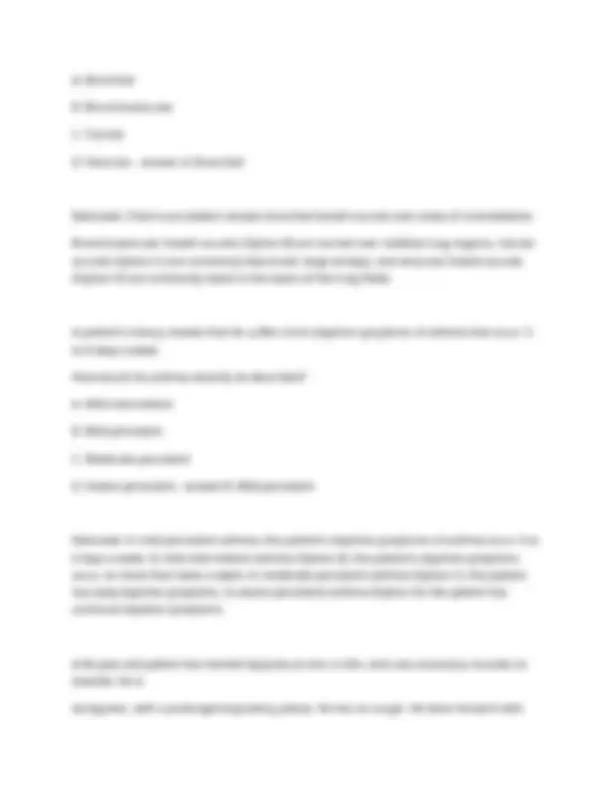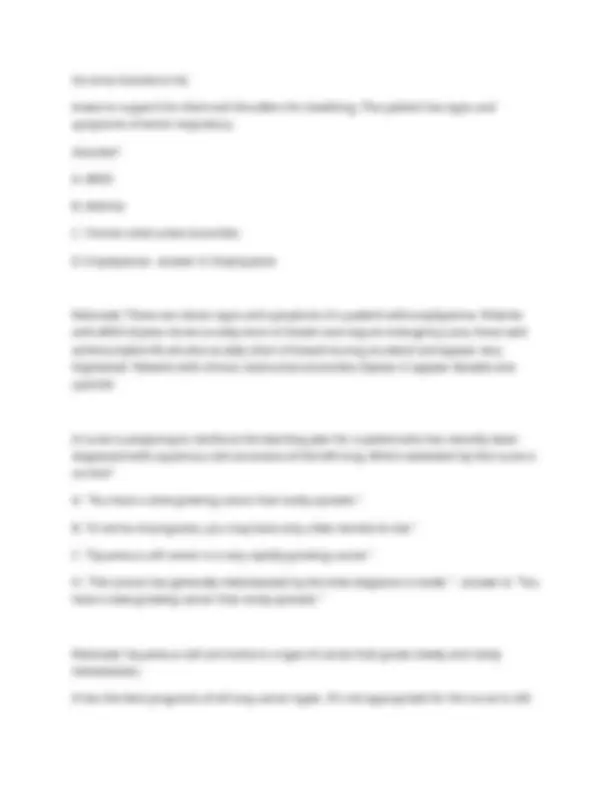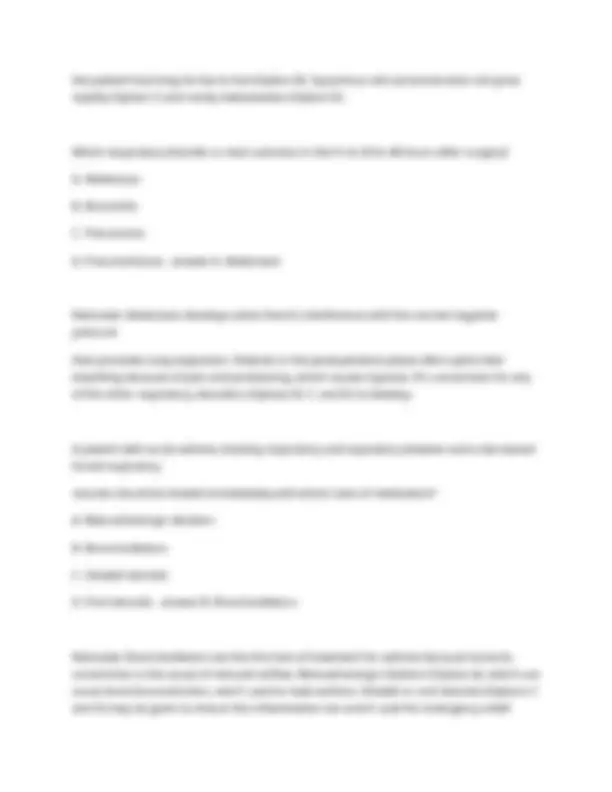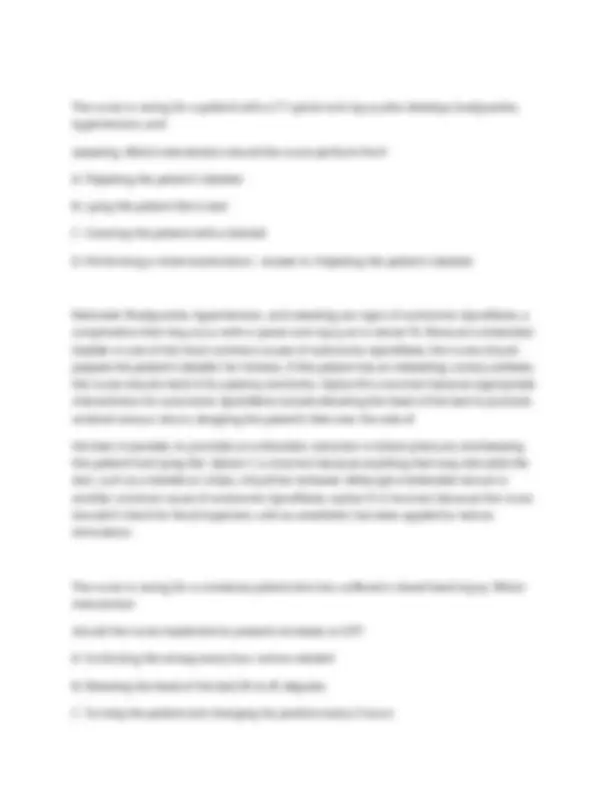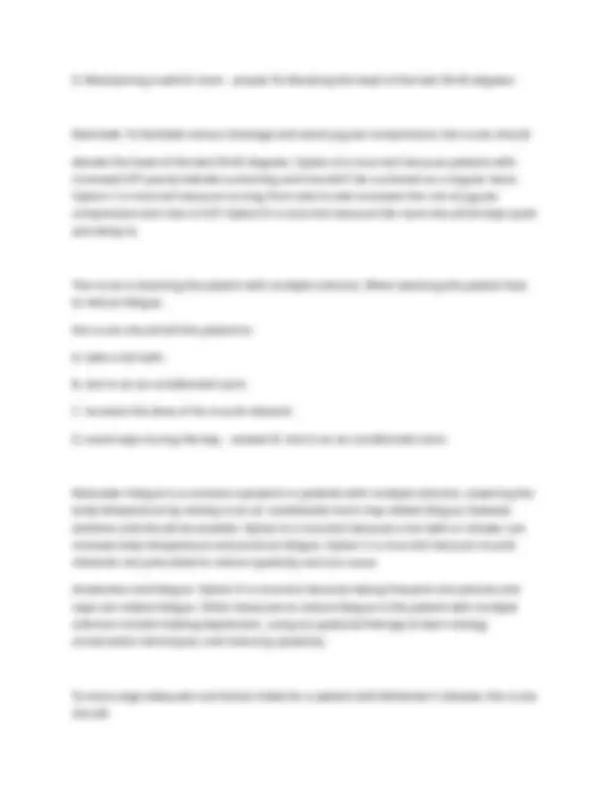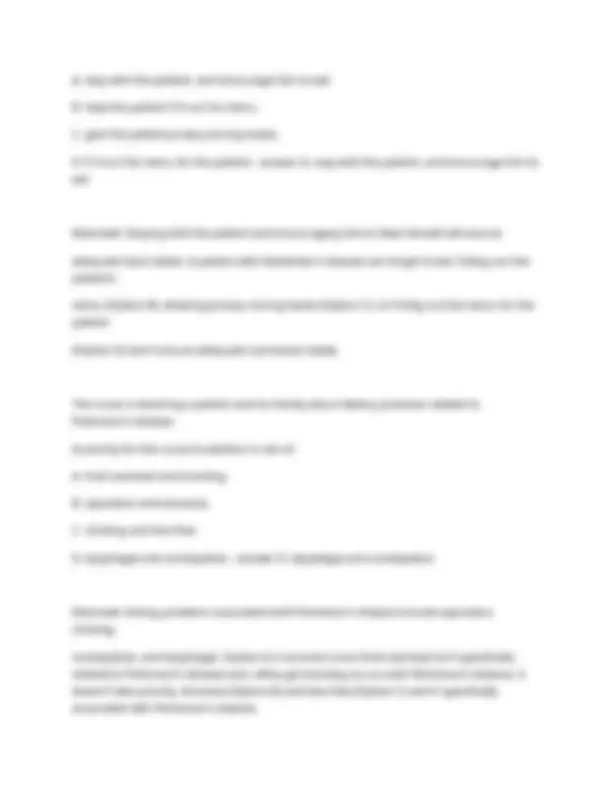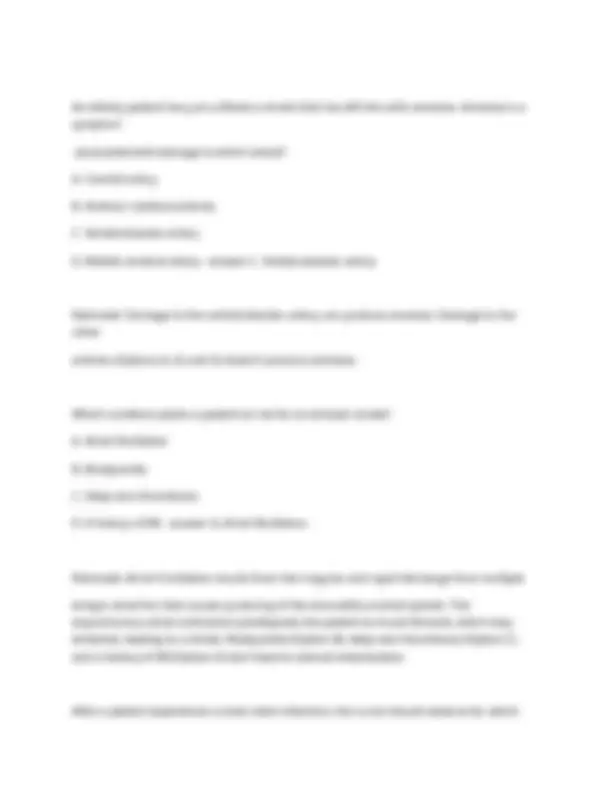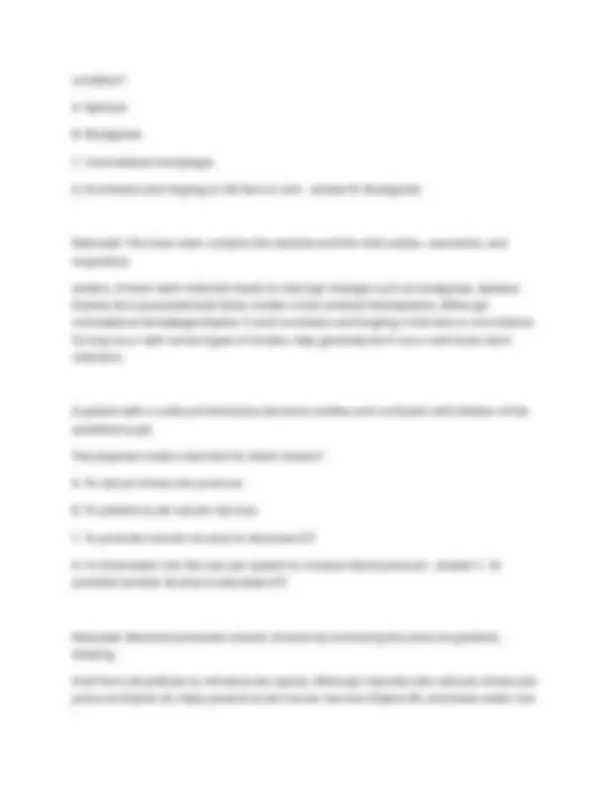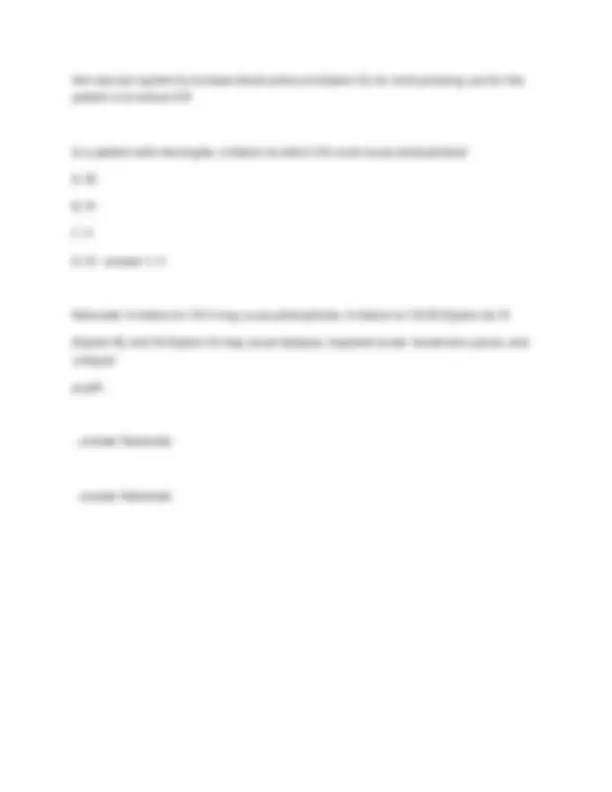Download Certified Medical-Surgical Registered Nurse 2025 Sample Questions And Complete Answers. and more Exams Nursing in PDF only on Docsity!
Certified Medical-Surgical Registered Nurse 2025 Sample
Questions And Complete Answers
The nurse receives all of the following stat orders for Mr. Palmer. Which one should the nurse question?
- Oxygen per nasal cannula at 4 L per minute.
- Enoxaparin (Lovenox) 40 mg subcutaneously.
- Troponin level.
- Computed tomography (CT) angiogram. - answer Rationale: The nurse should questions the order for Lovenox because the patient is receiving a heparin drip. Christine Warren, 45 years old, has a long history of ulcerative colitis, and non-surgical treatment no longer relieved her symptoms. She underwent a total proctocolectomy and a permanent ileostomy 12 hours ago. The nurse should contact the physician immediately if Mrs. Warren has which of these findings?
- The stoma appears pale and dry.
- The stoma appears red and shiny.
- There is 200 mL of dark green output from the stoma.
- There is 50 mL of serosanguinous drainage from the stoma. - answer 1) The stoma appears pale and dry. Rationale: If there is an adequate blood supply to the stoma, the color is pink or red, and the stoma is moist as a result of mucous production. A pale dry color suggests ischemia of the stoma or bowel and must be reported immediately to the physician. With an ileostomy initially after surgery, the output is a loose, dark green liquid that may contain some blood. The ileostomy usually begins to drain within 24 of surgery at more than one liter per day. When changing Mrs. Warren's ileostomy bag, the nurse notices that the peristomal skin is irritated.
Which of these actions by the nurse would be appropriate before reapplying the appliance?
- Wash the area with antiseptic soap and water.
- Clean the site with Dakin's solution.
- Use a solid skin barrier.
- Obtain an order for a topical antibiotic. - answer 3) Use a solid skin barrier. Rationale: The drainage from the stoma can quickly irritate the surrounding tissue. Therefore, a solid skin barrier, with a pectin base or karaya wafer that has a measurable thickness and hydrocolloid adhesive properties, should be applied. Which of these comments, if made by Mrs. Warren before her surgery, would indicate that she had concerns about her body image?
- "I will have to stop my aerobics classes."
- "I'm so afraid I may not survive the surgery."
- "I need to go shopping for some loose, baggy clothes."
- "I'm concerned that this may be only the first of many surgeries." - answer 3) "I need to go shopping for some loose, baggy clothes." Rationale:Body image refers to a person's perception of self and determines how the person interacts with others. One does not need to purchase special clothing after ileostomy surgery, although some minor adjustments may be needed for comfort, e.g., stretch underwear or pantyhose for support. To medical surgical nursing 11th edition by ignatavicius workman Test Bank or any other Test Banks email jamesdickson3161@gmail.comTest banks and other E books - answer Lewis Palmer, 45 years old, has a history of multiple myocardial infarctions and is a heavy smoker. He takes warfarin sodium (Coumadin) daily. Two weeks ago, he had a right femoral-popliteal bypass, which became occluded 24 hours ago. He is admitted following an angioplasty of the femoral-popliteal bypass graft. Mr. Palmer is receiving continuous IV heparin. Because Mr. Palmer is receiving heparin, it is essential for the nurse to
- monitor his prothrombin time.
- obtain her red blood cell count periodically.
- examine her urine for casts. - answer 1) monitor her glomerular filtration rate. Rationale: The estimated glomerular filtration rate (eGFR) is one way to measure the adequacy of kidney function. Glucophage is excreted by the kidney and the risk of lactic acidosis increases in patients with impaired kidney function. The drug may be used if the eGFR is between 45 and 60 mL/min/1.73 m2, i.e., in mild chronic kidney disease. Glucophage is absolutely contraindicated if the eGFR is below 30 mL/min/1.73 m2. Mrs. Clark is prescribed metoprolol tartrate (Lopressor) for hypertension. Which symptom of hypoglycemia would be masked by Lopressor?
- Diaphoresis.
- Tingling.
- Diplopia.
- Tachycardia. - answer 4) Tachycardia. Rationale: A side effect of Lopressor, a beta blocker, is bradycardia. The Lopressor-induced bradycardia can mask tachycardia, a symptom of hypoglycemia. Charles Haverford is diagnosed with prostate cancer and is to have a radical prostatectomy. Mr. Haverford has been researching his diagnosis and now asks the nurse to recommend a reliable web source for accurate prostate cancer information. The nurse should identify which of these websites as most reliable?
- www.wikipedia.org.
- www.cancer.gov.
- www.caringbridge.org.
- www.google.com. - answer 2) www.cancer.gov. Rationale: When a patient asks about researching information on the internet, the patient should be instructed to look at reliable sites. Sites that are most reliable are those sponsored by the government (.gov). Mr. Haverford has the planned surgery and immediately postoperatively he has a urinary
catheter inserted. After the urinary catheter is removed Mr. Haverford is urinating normally, however he is experiencing occasional incontinence with dribbling. Mr. Haverford is to be discharged. Mr. Haverford says to the nurse, "I'm so embarrassed. What will my wife think about this dribbling?" In addition to acknowledging his feelings, the nurse should encourage the patient to
- limit oral intake of fluids before bedtime.
- palpate his bladder to check for distention three times a day.
- perform pelvic floor exercises several times daily.
- avoid interrupting the urinary stream during voiding. - answer 3) perform pelvic floor exercises several times daily. Rationale: It is not unusual for a patient who has had a prostatectomy, to complain of not having complete bladder control after catheter removal. To help the patient regain urinary control, pelvic floor strengthening exercises are recommended. A patient's wife is visibly upset and says to the nurse, "I thought my husband only broke his hip, but the doctor thinks he might have had a stroke." Which of the following would be an appropriate response by the nurse?
- "It's really too early to be concerned about that. Let's wait until the test results come back."
- "If it is a stroke, your husband is in the right hospital for treatment."
- "Yes, he does have symptoms of a stroke. That's what the tests will help us find out."
- "I'm going to get you some information to read about strokes and their treatment." - answer 3) "Yes, he does have symptoms of a stroke. That's what the tests will help us find out."
A patient who has active pulmonary tuberculosis (TB) states, "I'm not going to take these TB pills!" Which of these responses by the nurse would be appropriate?
- "You have a legal right to refuse to take this medication."
- "You need to sign a Refusal of Treatment Form."
- "You need to ask your doctor about the possibility of discontinuing the medication."
- "You should know that the health department can require you to take the medication." - answer 4) "You should know that the health department can require you to take the medication." Rationale: Tuberculosis (TB) is a public health problem that requires reporting of the disease to the health department. It is essential that the patient understand the need to take prescribed TB medications as directed. Patients who are unwilling or unable to adhere to treatment may be required to do so by law or may be quarantined or isolated until noninfectious. State governments have legal responsibility for TB control activities, including treatment protocols for nonadherent patients. Health care workers should be familiar with the law in their particular states for these procedures. When a patient is having a chest tube removed, which of these instructions would be appropriate?
- "Take short quick breaths with your mouth open."
- "Take a deep breath and hold it."
- "Breathe only through your mouth."
- "Breathe as you normally do." - answer 2) "Take a deep breath and hold it." Rationale: Taking a deep breath and holding it (or performing the Valsalva maneuver) will prevent air from being pulled back into the pleural space as the tube is removed.
Using the average cost of a problem and the cost of intervention to demonstrate savings is: A. A cost-benefit analysis B. An efficacy study C. A product evaluation D. A cost-effective analysis - answer A. A cost-benefit analysis uses average cost of a problem (such as wound infections) and the average cost of intervention to demonstrate savings. For example, if a surgical unit averaged 10 surgical site infections annually at an additional average cost of $27,000 each, the total annual cost would be $270,000. If the total cost for interventions, (new staff person, benefits, education, and software) totals $92,000, and the goal is to reduce infections by 50% (0.5 X $270,000 for a total projected savings of $135,000), cost benefit is demonstrated by subtracting the proposed savings from the intervention costs ($135,000 - $92,000) for a savings of $43,000 annually. In Erikson's psychosocial model of development, which stage is typical of those entering young adulthood? A.Identify vs role confusion B.Initiative vs guilt C.Ego integrity vs despair D.Intimacy vs isolation - answer D. Erickson's psychosocial development model focuses on conflicts at each stage of the lifespan and the virtue that results from finding balance in the conflict. The first 5 stages refer to infancy and childhood and the last 3 stages to adulthood: Intimacy vs isolation (Young adulthood): Love/intimacy or lack of close relationships.
B.Impaired physical mobility C.Risk for disuse syndrome D.Activity intolerance - answer C. The most appropriate nursing diagnosis for a person who is able to exercise but remains sedentary is risk of disuse syndrome because the patient is putting himself at risk for the development of circulatory impairment and muscle atrophy. Failure to exercise may also exacerbate his condition. While his health maintenance may be ineffective, it is directly due to of his lack of activity. He does not have impaired physical mobility or activity intolerance that precludes exercise. Measuring the effectiveness of an intervention rather than the monetary savings is: A.A cost-benefit analysis. B.An efficacy study. C.A product evaluation. D.A cost-effective analysis. - answer D. A cost-effective analysis measures the effectiveness of an intervention rather than the monetary savings. For example, annually 2 million nosocomial infections result in 90,000 deaths and an estimated $6.7 billion in additional health costs. From that perspective, decreasing infections should reduce costs, but there are human savings in suffering as well, and it can be difficult to place a dollar value on that. If each infection adds about 12 days to hospitalization, then a reduction of 5 infections (5 X 12 = 60) would result in a cost-effective savings of 60 fewer patient infection days. The main goal of treatment for acute glomerulonephritis is to:
- Encourage activity.
- Encourage high protein intake.
- Maintain fluid balance.
- Teach intermittent urinary catheterization. - answer 3. Maintain fluid balance. Nursing diagnoses mostly differ from medical diagnoses in that they are:
- Dependent upon medical diagnoses for the direction of appropriate interventions.
- Primarily concerned with caring, while medical diagnoses are primarily concerned with curing.
- Primarily concerned with human response, while medical diagnoses are primarily concerned with pathology.
- Primarily concerned with psychosocial parameters, while medical diagnoses are primarily concerned with physiologic parameters. - answer 3. Primarily concerned with human response, while medical diagnoses are primarily concerned with pathology. A patient who received spinal anesthesia four hours ago during surgery is transferred to the surgical unit and, after one and a half hours, now reports severe incisional pain. The patient's blood pressure is 170/90 mm Hg, pulse is 108 beats/min, temperature is 99oF (37.2oC), and respirations are 30 breaths/min. The patient's skin is pale, and the surgical dressing is dry and intact. The most appropriate nursing intervention is to:
- Medicate the patient for pain.
- Place the patient in a high Fowler position and administer oxygen.
- Place the patient in a reverse Trendelenburg position and open the IV line.
- Report the findings to the provider. - answer 1. Medicate the patient for pain. To prevent a common, adverse effect of prolonged use of phenytoin sodium (Dilantin), patients taking the drug are instructed to:
surgical nurse notes the development of slurred speech and disorientation to time and place. The nurse's initial action is to:
- Continue the hourly neurologic assessments.
- Inform the neurosurgeon of the patient's status.
- Prepare the patient for emergency surgery.
- Recheck the patient's neurologic status in 15 minutes. - answer 2. Inform the neurosurgeon of the patient's status. For the evaluation feedback process to be effective, a manager:
- Conducts weekly meetings with staff members.
- Considers staff members' interests and abilities when delegating tasks.
- Informs staff members regularly of how well they are performing their jobs.
- Provides goals for staff members to meet. - answer 3. Informs staff members regularly of how well they are performing their jobs. An 80-year-old patient is placed in isolation when infected with methicillin-resistant Staphylococcus aureus. The patient was alert and oriented on admission, but is now having visual hallucinations and can follow only simple directions. The medical-surgical nurse recognizes that the changes in the patient's mental status are related to:
- A fluid and electrolyte imbalance.
- A stimulating environment.
- Sensory deprivation.
- Sundowning. - answer 3. Sensory deprivation.
To prepare a patient on the unit for a bronchoscopic procedure, a medical-surgical nurse administers the IV sedative. The medical-surgical nurse then instructs the licensed practical nurse to:
- Educate the patient about the pending procedure.
- Give the patient small sips of water only.
- Measure the patient's blood pressure and pulse readings.
- Take the patient to the bathroom one more time. - answer 3. Measure the patient's blood pressure and pulse readings. Which physiological response is often associated with surgery-related stress?
- Bronchial constriction
- Decreased cortisol levels
- Peripheral vasodilation
- Sodium and water retention - answer 4. Sodium and water retention A patient's family does not know the patient's end-of-life care preferences, but assumes that they know what is best for the patient under the circumstances. This assumption reflects:
- Justice.
- Paternalism.
- Pragmatism.
- Veracity. - answer 2. Paternalism.
Which is primarily a developmental task of middle age?
- Learning and acquiring new skills and information
- Rediscovering or developing satisfaction in one's relationship with a significant other
- Relying strongly upon spiritual beliefs
- Risk taking and its perceived consequences - answer 2. Rediscovering or developing satisfaction in one's relationship with a significant other A medical-surgical nurse, who is caring for a patient with a new diagnosis of cancer, observes the patient becoming angry with the physicians and nursing staff. The best approach to diffuse the emotionally charged discussion is to:
- Allow the patient and family members time to be alone.
- Arrange time for the patient to speak with another patient with cancer.
- Direct the discussion and validation of emotion, without false reassurance.
- Request a consultation from a social worker on the oncology unit. - answer 3. Direct the discussion and validation of emotion, without false reassurance. It is hospital policy to assess and record a patient's pulse before administering digoxin (Lanoxin). By auditing the nursing records to determine the frequency of compliance with this policy, the quality assessment and improvement committee is conducting:
- A process analysis.
- A quality analysis.
- A system analysis.
- An outcome analysis. - answer 1. A process analysis.
The nursing diagnosis for a patient with a myocardial infarction is activity intolerance. The plan of care includes the patient outcome criterion of:
- Agreeing to discontinue smoking.
- Ambulating 50 feet without experiencing dyspnea.
- Experiencing no dyspnea on exertion.
- Tolerating activity well. - answer 2. Ambulating 50 feet without experiencing dyspnea. A nursing department in an acute care setting decides to redesign its nursing practice based on a theoretical framework. The feedback from patients, families, and staff reflects that caring is a key element. Which theorist best supports this concept?
- Erikson
- Maslow
- Rogers
- Watson - answer 4. Watson Which statement by a patient demonstrates an accurate understanding about herbal supplements?
- "Herbs may interact with prescribed medications but not other herbs."
- "Most herbs have been tested and found to be safe and therapeutic."
- "The Food and Drug Administration regulates herbs and allows advertising."
- "There is no standardization among the manufacturers of herbs in this country." - answer 4. "There is no standardization among the manufacturers of herbs in this country."
The first step in applying the quality improvement process to an activity in a clinical setting is to:
- Assemble a team to review and revise the activity.
- Collect data to measure the status of the activity.
- Select an activity for improvement.
- Set a measurable standard for the activity. - answer 3. Select an activity for improvement. The registered nurse has an unlicensed assistant working with her for the shift. When delegating tasks, the nurse understands that the unlicensed assistant: A. interprets clinical data. B. collects clinical data. C. is trained in the nursing process. D. can function independently - answer B. collects clinical data. Rationale: Unlicensed personnel make observations, collect clinical data, and report findings to the nurse. Option A is incorrect because the registered nurse, who has learned critical thinking skills, interprets the data. Option C is incorrect because although unlicensed assistants are trained to perform skills, they don't learn the nursing process. Option D is incorrect because unlicensed assistants don't function independently; they're assigned tasks by a registered nurse who retains overall responsibility for the patient.
When performing an assessment, the nurse identifi es the following signs and symptoms: impaired coordination, decreased muscle strength, limited range of motion, and reluctance to move. These signs and symptoms indicate which nursing diagnosis? A. Health-seeking behaviors B. Impaired physical mobility C. Disturbed sensory perception D. Deficient knowledge - answer B. Impaired physical mobility Rationale:Impaired physical mobility is a limitation of physical movement and is defined by the patient's signs and symptoms. Options A, C, and D are nursing diagnoses with different defining signs and symptoms. When prioritizing a patient's care plan based on Maslow's hierarchy of needs, the nurse's fi rst priority would be: A. allowing the family to see a newly admitted patient. B. ambulating the patient in the hallway. C. administering pain medication. D. using two nurses to transfer the patient. - answer C. administering pain medication. Rationale: In Maslow's hierarchy of needs, pain relief is on the first layer. Activity (Option B) is on the second layer.

